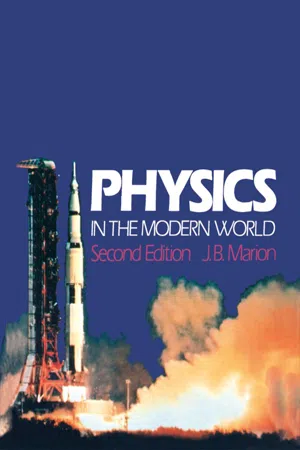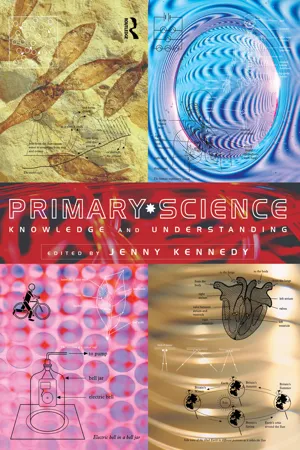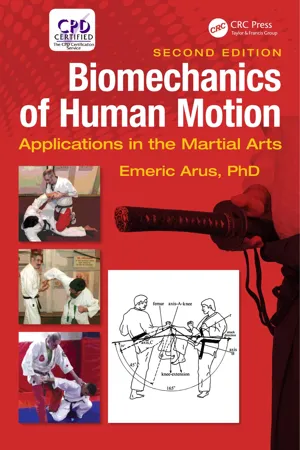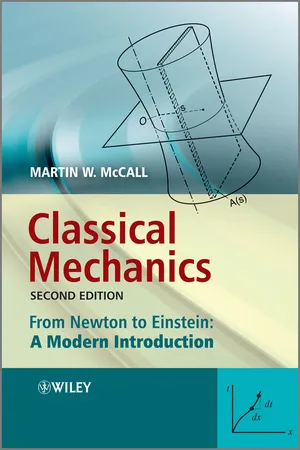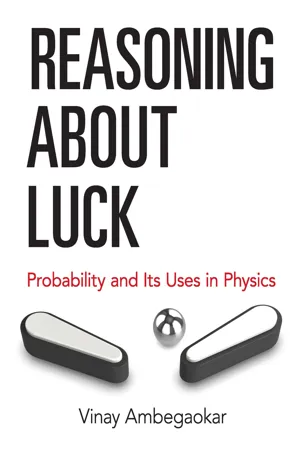Physics
Force and Motion
Force and motion are fundamental concepts in physics that describe the interaction between objects and their resulting movement. Force is a push or pull acting on an object, causing it to accelerate, decelerate, or change direction. Motion refers to the change in position of an object over time, influenced by the application of force.
Written by Perlego with AI-assistance
Related key terms
12 Key excerpts on "Force and Motion"
- eBook - ePub
- A. L. Stanford, J. M. Tanner(Authors)
- 2014(Publication Date)
- Academic Press(Publisher)
3Force and Motion: Particle Dynamics
Publisher Summary
This chapter discusses Force and Motion in relation to particle dynamics. Any influence that can cause a body to accelerate is called a force. The study of the motion of particles in terms of the forces associated with that motion is called particle dynamics. A body has a constant velocity unless it is acted on by a net force. Many individual forces may act on a body, but the resultant or net force must be equal to zero if the body is not to accelerate. The assertion that a body on which there is no net force experiences no acceleration implies that a moving body will maintain a constant velocity forever unless acted on by a net force. Newton’s first law, however, does not apply to all reference frames, the coordinate systems. The application of Newton’s laws usually means solving dynamics problems, which are commonly stated as word problems. The basic issue in dynamics problems is solving the fundamental dynamic equation, ∑F = m a. Perhaps the most common form of problem in dynamics requires that the acceleration of a given mass be determined when the mass is subjected to known forces. Sometimes more than one mass is involved; occasionally the mass is the unknown quantity to be determined.We have been considering the motion and changes in motion of particles without regard to what might have influenced those changes. In Chapter 2 we learned to recognize a change in motion as acceleration. Any influence that can cause a body to accelerate will now be called a force . Force, which we recognize intuitively as a push or a pull, is a fundamental interaction between physical bodies that can produce changes in the velocities of the bodies. The study of the motion of particles in terms of the forces associated with that motion is called particle dynamics - eBook - ePub
- Hiqmet Kamberaj(Author)
- 2021(Publication Date)
- De Gruyter(Publisher)
5 The laws of motionSo far, we described motion in terms of displacement, velocity, and acceleration without considering the cause of that motion. For example, what causes one particle to stay at rest and another particle to accelerate? Here, we investigate what causes changes in motion. The two main factors that are usually considered are the forces acting on an object and its mass. We will discuss the three fundamental laws of motion, which are related to forces and masses. These laws were formulated more than three centuries ago by Isaac Newton. These laws allow understanding the mechanism of changing the state of motion and the degree of acceleration of different objects.5.1 The concept of force
Our basic understanding of the concept of force comes from everyday experience. For example, consider the experiment of pushing or pulling a desk, we exert a force on it. Similarly, when we throw a ball, we exert a force on the ball to throw it. In these typical examples, the force is related to muscular activity and some changes in the velocity of the object. However, it is important to understand that forces do not always cause motion. For example, we can push the wall of the building, but we are not able to move it.A body accelerates because of an external force
Newton was able to answer the question of what force causes the planets to orbit around the Sun, and related questions by stating that forces are what cause any change in the velocity of an object. Thus, no force is required for the motion with a constant velocity of an object to be maintained. For example, the Moon’s velocity is not constant because it moves in a nearly circular orbit around the Earth because of the force exerted on the Moon by the Earth. Therefore, since the velocity of objects changes whenever a force is applied to them, then the forces make the objects accelerate. Here, we are concerned with the relationship between the force exerted on an object and the acceleration of that object. - eBook - ePub
- Serhii Stepanov(Author)
- 2018(Publication Date)
- De Gruyter(Publisher)
5Force and equations of motion Although much information about particle interactions can be derived from the conservation laws, equations of motion are required for a more detailed description.We will study the concept of force and a generalization of Newton’s second law to describe particles moving in an external force field. We will then find out which properties a force should have so that the total energy and the total momentum of a particle are conserved. In general, such a force can be a function of the particle’s velocity.We consider the motion of relativistic particles subject to a constant force, a central field, and a spherically symmetric field. If in the spherically symmetric case the force is a function of the test particle’s velocity, the particle’s orbit is subject to additional precession in accordance with Einstein’s theory of gravity.5.1Definition of force
Predicting the future is the main task of physics. In classical mechanics, the dynamics of particles are described by second-order differential equations. Therefore, their coordinates can be found as functions of time from their initial positions and velocities. The situation is much more complex in relativistic mechanics, so a new dynamic quantity, the interaction field, must be defined in order to describe a system of interacting particles. Nevertheless, the classical approach involving second-order differential equations can be used for “small” particles moving in an external field. Particles which have no counter-impact on the sources of the force field are called test particles.Newton’s second law is in some sense a definition of force in classical mechanics:F = m a(i.e. force is a function of the particle’s position and velocity and is proportional to its acceleration). The same definition can be written as F = d p /dt , where p = m u is the non-relativistic momentum of the particle. These two relations are not equivalent in relativistic theory where the following definition - eBook - ePub
- Jerry Marion(Author)
- 2012(Publication Date)
- Academic Press(Publisher)
3FORCE
Publisher Summary
This chapter explains the concept of force and its relation to the behavior of objects at rest and in motion. The mass of an object is important in any effort to change its state of motion. The property of an object that tends to resist any change in its state of motion is called inertia. The measure of an object’s inertia is its mass. The chapter discusses Newton’s first, second, and third law of motion. A force is any influence that can cause a change in the state of motion of an object. Mass is an intrinsic property of matter; it is a measure of the inertia possessed by an object—that is, the tendency of the object to resist changes in its state of motion. Weight is the gravitational force acting on an object, and this force depends on the location of the object. Variation causes an object to have different weights even though its mass is constant.In the preceding chapter we developed methods for describing and analyzing motion. But what causes motion? You know that if you push or pull (sufficiently hard) on a lawnmower, it can be set into motion. Or, if you apply a restraining push or pull to a bowling ball, the ball can be slowed down and brought to rest. In every such case, some force —represented by a push or pull—must be applied to an object in order to change its state of motion. In this chapter we examine the concept of force and its relation to the behavior of objects at rest and in motion.3-1 FORCE AND INERTIA
Intuitive Ideas
The intuitive notion that a force is a push or a pull is entirely consistent with the precise physical definition of this important quantity. We have other, equally correct intuitive ideas about force. For example, if you push in a certain direction on an object at rest, the object tends to move in that direction. Or, if you wish to stop a moving object, you must exert a push in the direction opposite to that of the object’s motion. That is, force has direction as well as magnitude —force is a vector quantity. We also appreciate the fact that the mass of an object is important in any effort to change its state of motion. A kick applied to a soccer ball will send the ball flying; but a kick applied to a bowling ball will result in only a slight motion of the ball (and a bruised toe). The property of an object that tends to resist any change in its state of motion is called inertia; the measure of an object’s intertia is its mass - eBook - ePub
Doing Physics with Scientific Notebook
A Problem Solving Approach
- Joseph Gallant(Author)
- 2012(Publication Date)
- Wiley(Publisher)
Chapter 5Newton’s Laws of Motion
In the previous chapters on kinematics, we described motion in a quantitative sense. Once we know an object’s acceleration, we can describe its motion in terms of position, velocity, and time. Knowing how its motion changes lets us calculate how far, how fast, and how long the object moves.Now we move to a branch of physics known as dynamics. Dynamics is the study of the effects of forces on an object’s motion. Dynamics explains changes in motion by relating the cause of the changes (forces) to the effect (acceleration). Newton’s Second Law provides the rule relating the acceleration to the net force.There are three ingredients to Newton’s Second Law: the object’s acceleration, mass, and the net force acting on it. As we discussed in Chapter 2, the object’s acceleration is the rate of change in its velocity. Mass is a property of the object that determines how much change the net force produces. An object’s mass tells you how difficult it is to change its velocity and how much matter it has.A force is a push or a pull that can cause changes in motion. Forces are vectors, so they have magnitude and direction. This is consistent with your experience. When you exert a force on something, two things matter: how hard you push or pull and which way. Often objects have more than one force acting on them. The net force acting on an object is the vector sum of all the forces acting on it.Newton’s First Law
Newton’s First Law tells us what happens when there is no net force acting on an object.Newton’s 1st Law: An object will remain in a state of rest or continue in motion at a constant velocity unless compelled to change by a non-zero net force.When there is no net force acting on the object, there is no change in the object’s velocity. If it is at rest, it remains at rest. If it is moving, it keeps moving at constant velocity. Since velocity is a vector, constant velocity means no change in both speed and direction. Motion at constant velocity is motion in a straight line at a constant speed. - eBook - ePub
Primary Science
Knowledge and Understanding
- Jenny Kennedy(Author)
- 2013(Publication Date)
- Routledge(Publisher)
9 Forces and Motion JIM JARDINE AND JENNY KENNEDY Introduction What is a force? What can forces do? Other forces Forces on a motionless object Weight Floating and sinking Forces always come in pairs Falling objects – air resistance Friction between solids Keeping going Speed SummaryPassage contains an image
9
JIM JARDINE JENNY KENNEDYFORCES AND MOTIONINTRODUCTION
The meaning of the word ‘force’
In general use, the word ‘force’ often conveys the idea of intense effort and even violence. But in science a force is simply a push or a pull, no matter how small. You exert a small force to blow a crumb from the table (a push), or to lift a spoon (a pull). If a broken-down car is to be shifted, you could exert a large push from behind, or get a breakdown truck to exert a large pull forward, or a crane to exert a large force upward to lift it on to the truck.In Figure 9.1 arrow-heads are used to show the directions of the forces mentioned and the places where they are applied, although there is nothing to indicate the relative sizes of those forces.WHAT IS A FORCE?All around us there are examples of forces being exerted. You provide forces when you push a bicycle along, pull a push-chair up a step, open a drawer, throw a ball, and so on. A force is a push or a pull. Notice that a force is needed to start something moving, although, as we shall see, a force may not be necessary to keep it moving.It is important to realise that in each of those examples there are also many other forces acting on the objects shown. In the case of the bike, in addition to the girl’s push, there is the pull of gravity downward, which we call the bike’s weight; the support of the ground pushing up on the bike; and the frictional forces of the road on the tyres and of the air pushing back on the whole bike (see Figure 9.2 - eBook - ePub
Newtonian Dynamics
An Introduction
- Richard Fitzpatrick(Author)
- 2021(Publication Date)
- CRC Press(Publisher)
Nowadays, Newton’s first law strikes us as almost a statement of the obvious. However, in Galileo’s time, this was far from being the case. From the time of the ancient Greeks, philosophers—observing that objects set into motion on the Earth’s surface eventually come to rest—had concluded that the natural state of motion of objects was that they should remain at rest. Hence, they reasoned, any object that moves does so under the influence of an external influence, or force, exerted upon it by some other object in the universe. It took the genius of Galileo to realize that an object set into motion on the Earth’s surface eventually comes to rest under the influence of frictional forces, and that, if these forces could somehow be abstracted from the motion then the motion would continue forever.4.3 Newton’s Second Law of Motion
Newton used the word “motion” to mean what we nowadays call momentum. The momentum, p, of a body is defined as the product of its mass, m, and its velocity, v; that is,Newton’s second law of motion is summed up in the equationp = m v .(4.2)(4.3)= f ,d pd twhere the vector f represents the net influence, or force, exerted on the object, whose motion is under investigation by other objects in the universe. For the case of a object with constant mass, the previous law reduces to its more conventional formm a = f .(4.4)In other words, the product of a given object’s mass and its acceleration,a = d v / d t, is equal to the net force exerted on that object by the other objects in the universe. Of course, this law is entirely devoid of content unless we have some independent means of quantifying the forces exerted between different objects.4.4 Measurement of Force
One method of quantifying the force exerted on an object is via Hooke’s law. (See Section 5.6 .) This law—discovered by the English scientist Robert Hooke in 1660—states that the force, f, exerted by a coiled spring is directly proportional to its extension,Δ x - eBook - ePub
Biomechanics of Human Motion
Applications in the Martial Arts, Second Edition
- Emeric Arus, Ph.D.(Authors)
- 2017(Publication Date)
- CRC Press(Publisher)
8Kinetics in Linear Motion
8.1 INERTIA, MASS, WEIGHT, AND FORCE
The four words inertia, mass, weight, and force are very closely related to each other. Inertia is the property of mass that causes it to resist any change in its motion or its state of stillness. Thus, a body at rest remains at rest unless it is acted upon by an external force and the body in motion continues to move at constant speed in a straight line unless acted upon by an external force. This statement represents Newton’s first law of motion.The mass is a measure of a body’s inertia, that is, its resistance to acceleration. The mass of an object is constant everywhere. The weight is a force of attraction exerted on an object by the gravitational pull of the Earth. Weight on Earth has different values depending on the place where the object is. Being a force, weight should be measured in Newton (N), and a body of mass will have a weight = m ⋅ g , where ( g ) is the acceleration of free fall or gravity (9.80665 m/s2 ). The kilogram (kg) is an SI base unit of mass. From here results that a mass of 1 kg = 9.8 m/s2 . A man of 70 kg mass × 9.8 m/s2 will have 686 Newton force.8.2 FORCES
Recall that kinetics deal with motion that includes the forces that cause the motion. The physical property of the force , perhaps, is the most important between other physical properties, such as momentum, impulse, energy, velocity, and so on, which are related to objects in static positions or dynamic motions, including humans and animals alike. Force is described as the effect one object has on another, which can alter the state of a matter by pushing, pulling, twisting, sliding, and so on, and this effect of the force (F ) is the product of a mass and its acceleration F = m ⋅ a. - eBook - ePub
Classical Mechanics
From Newton to Einstein: A Modern Introduction
- Martin W. McCall(Author)
- 2011(Publication Date)
- Wiley(Publisher)
Ft .Another quantity sometimes introduced is the rate of doing work:- Power, P , is the rate of doing work:
(2.15)The SI unit of power is the watt, equivalent to the rate of working at 1 joule per second. Power is sometimes used in contexts where no net force is acting, which can be a little confusing. When we drive a car along the road with the accelerator depressed it moves because a constant force is applied to the wheels through the burning of fuel. However, resistance from the road and the rotary motion of the car’s transmission opposes the car’s motion so that in the steady state no net force is applied. According to Newton’s first law the car then moves with constant velocity, and the power developed by the engine is that required to overcome friction and to maintain the car’s speed. Perhaps the right pedal would be better named the ‘velocirater’!2.6 Motion with a Position-dependent ForceAlthough we’ve worked it out for a constant force, the definition covers the case F = F (x ) as well. Many forces depend on the location of a body and not explicitly on time or the body’s velocity. We refer in such cases to a field of force. Gravity is the most familiar example, though we have to go to a height that is comparable with the Earth’s radius before the acceleration due to gravity changes noticeably. In the context of one-dimensional motion, the position dependence is with respect to a single spatial variable, which we call x . Unlike the case of position-independent forces, m = F (x ) can no longer be integrated with respect to time directly (since x = x (t )), so we must proceed differently. First, let us generalise the definition of work from Equation (2.9 - eBook - ePub
Making Physics Fun
Key Concepts, Classroom Activities, and Everyday Examples, Grades K?8
- Robert Prigo(Author)
- 2015(Publication Date)
- Skyhorse(Publisher)
In other word, objects do not need any cause to keep moving in a straight line with constant speed. That is just the way it is. This is the default of nature. As we will see later, forces are responsible for changing motion (speeding up, slowing down, and/or turning) but are not needed for straight-line, constant-speed motion. If you could snap your fingers and turn off all the forces in the universe, you would see all the fundamental particles that are the building blocks of matter moving in straight lines with constant speeds. Indeed, the concept of inertia is the backdrop against which all motion is played out. It is absolutely fundamental to our understanding of motion. Unfortunately, we live in a world dominated by electrical and gravitational forces, so it is natural that children possess the misconception that forces are needed for motion. Indeed, many children hold the misconceptions that constant motion requires a constant force, and that if an object is moving there is a force on it in the direction of its motion, with the amount of motion being proportional to the amount of force (Gunstone & Watts, 1985). Forces are not required to maintain motion. Straight-line, constant-speed motion just happens on its own without the need for any external agents. Forces (external pushes and pulls) cause a change in motion - eBook - ePub
- Vinay Ambegaokar(Author)
- 2017(Publication Date)
- Dover Publications(Publisher)
6
Forces, motion, and energy
... the whole burden of philosophy seems to consist in this – from the phenomena of motions to investigate the forces of nature, and then from these forces to demonstrate the other phenomena ... Isaac NewtonProbability enters theoretical physics in two important ways: in the theory of heat, which is a manifestation of the irregular motions of the microscopic constituents of matter; and, in quantum mechanics, where it plays the bizarre but, as far as we know, fundamental role already briefly mentioned in the discussion of radioactive decay.Before we can understand heat, we have to understand motion. What makes objects move, and how do they move? Isaac Newton, in the course of explaining the motion of planets and of things around us that we can see and feel with our unaided senses, answered these questions for such motions three centuries ago. The science he founded has come to be called classical or Newtonian mechanics, to distinguish it from quantum mechanics, the theory of motion in the atomic and sub-atomic world.Classical mechanics is summarized in Newton’s laws’ of motion. These will here be illustrated by an example involving the gravitational attraction, described by Newton’s ‘law’ of gravitation. In the brief description that follows, I shall attempt to show that these laws of nature: (i) unify apparently unrelated phenomena – like the motion of the moon and the fall of an apple; (ii) make simple but astonishing quantitative connections – between, for example, the rate of the moon’s revolution around the earth and the numerical value of the acceleration in an apple’s fall; and (iii), suggest new and useful concepts – here kinetic energy, potential energy, and, more generally, energy – which provide access to unexplored territory.To say that an object moves is to say that its position in space changes with time. This can only be given meaning by referring it to some fixed point. Imagine a straight line directed from such a fixed point to the place where our object is. This directed line is called the position ‘vector’ of the object. The word vector is used to indicate something that has a magnitude and a direction. We shall encounter other vector quantities soon. Two vectors are said to be equal when they have the same magnitude and - eBook - ePub
- Michael M. Mansfield, Colm O'Sullivan(Authors)
- 2020(Publication Date)
- Wiley(Publisher)
4 Motion in two and three dimensionsAIMS
- to show how, in two and three dimensions, physical quantities can be represented by mathematical entities called vectors
- to rewrite the laws of dynamics in vector form
- to study how the laws of dynamics may be applied to bodies which are constrained to move on specific paths in two and three dimensions
- to describe how the effects of friction may be included in the analysis of dynamical problems
- to study the motion of bodies which are moving on circular paths
4.1 Vector physical quantities
The material universe is a three‐dimensional world. In our investigation of the laws of motion in Chapter 3 , however, we considered only one‐dimensional motion, that is situations in which a body moves on a straight line and in which all forces applied to the body are directed along this line of motion. If a force is applied to a body in a direction other than the direction of motion the body will no longer continue to move along this line. In general, the body will travel on some path in three‐dimensional space, the detail of the trajectory depending on the magnitude and direction of the applied force at every instant. Equation (3.3) as it stands is not sufficiently general to deal with such situations, for example the motion of a pendulum bob (Figure 4.1 ) or the motion of a planet around the Sun (Figure 4.2 ). Newton's second law needs to be generalised from the simple one‐dimensional form discussed in Chapter 3 .A pendulum comprising a mass attached to the end of a string; the mass can move on a path such that the distance from the fixed end of the string remains constant.Figure 4.1A similar problem arises if two or more forces act on a body simultaneously, for example when a number of tugs are manoeuvring a large ship (Figure 4.3
Index pages curate the most relevant extracts from our library of academic textbooks. They’ve been created using an in-house natural language model (NLM), each adding context and meaning to key research topics.



